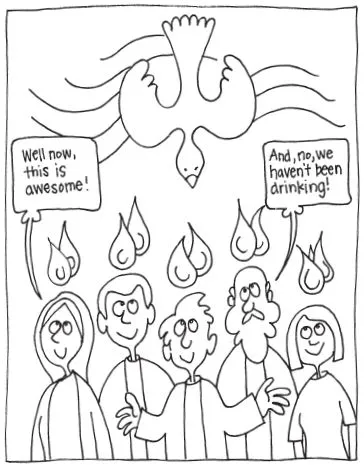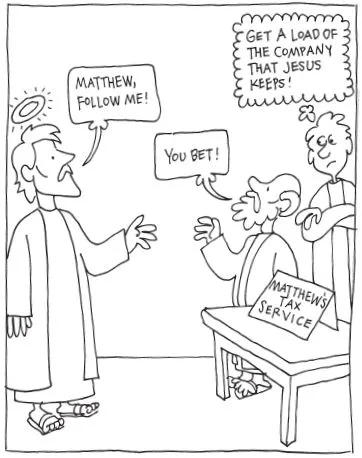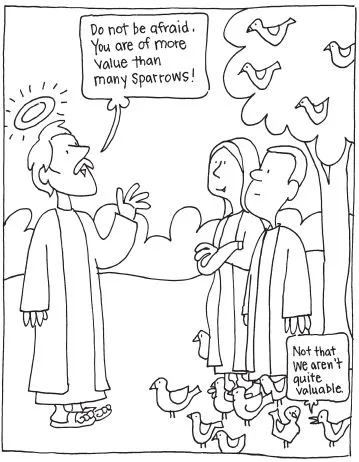
eBook - ePub
Drawn to the Gospels
An Illustrated Lectionary (Year A)
Jay Sidebotham
This is a test
- English
- ePUB (mobile friendly)
- Available on iOS & Android
eBook - ePub
Drawn to the Gospels
An Illustrated Lectionary (Year A)
Jay Sidebotham
Book details
Book preview
Table of contents
Citations
About This Book
Each week brings a lighthearted opportunity to remember that humor and the gospel are not mutually exclusive.
The second in a series of three books brings weekly gospel readings to life. Each week, a cartoon illustration and text of the gospel creates a lighthearted opportunity for individual reflection, or an enjoyable addition to study materials and church bulletins. These amusing and original reflections deepen scriptural literacy and engagement among members of the Episcopal Church, including youth groups, and will inspire some fun in the process.
Frequently asked questions
How do I cancel my subscription?
Can/how do I download books?
At the moment all of our mobile-responsive ePub books are available to download via the app. Most of our PDFs are also available to download and we're working on making the final remaining ones downloadable now. Learn more here.
What is the difference between the pricing plans?
Both plans give you full access to the library and all of Perlego’s features. The only differences are the price and subscription period: With the annual plan you’ll save around 30% compared to 12 months on the monthly plan.
What is Perlego?
We are an online textbook subscription service, where you can get access to an entire online library for less than the price of a single book per month. With over 1 million books across 1000+ topics, we’ve got you covered! Learn more here.
Do you support text-to-speech?
Look out for the read-aloud symbol on your next book to see if you can listen to it. The read-aloud tool reads text aloud for you, highlighting the text as it is being read. You can pause it, speed it up and slow it down. Learn more here.
Is Drawn to the Gospels an online PDF/ePUB?
Yes, you can access Drawn to the Gospels by Jay Sidebotham in PDF and/or ePUB format, as well as other popular books in Teologia e religione & Studi biblici. We have over one million books available in our catalogue for you to explore.
Information
Topic
Teologia e religioneSubtopic
Studi biblici
Day of Pentecost
John 20:19–23

or John 7:37–39
Notes on These Readings
The early church adopted and adapted a Jewish feast, the feast of Pentecost, to note the day that the Holy Spirit descended on the disciples, filling them with power represented by fire and wind, giving them the gift of many languages, establishing them as a community that in short order would change the world. For that reason, it has often been called the birthday of the church. This particular day, recorded in chapter 2 of the Acts of the Apostles, was marked by extraordinary events, but the main point was that God was still very much present with the group of disciples, and that they had indeed received the power that they needed to make a difference.
Questions
- Take time to read the story of Pentecost in Acts 2. How does it compare with the readings from the Gospel of John? What’s similar? What’s different?
- In John’s gospel, Jesus breathes on the disciples to share his power. In Acts, the power comes with a mighty wind. How have you received power to live a life of faith in the world? Where did that power come from?
- What is important about breath and wind in the spiritual life? Note how many religious traditions focus on breath and wind.

Trinity Sunday
Matthew 28:16–20
Notes on This Reading
This Sunday is the only Sunday of the church year specifically dedicated to a doctrine or teaching of the church. After the great celebration of the gift of the Spirit, observed last week on Pentecost, this week we focus on the doctrine at the heart of our faith, the Trinity. It’s a mysterious teaching for sure. It claims that God is one in three persons, a teaching reflected in the creeds of the church, a teaching implied in scripture but rarely explicitly set forth until several centuries after the church began. For this Sunday, we read the final verses of Matthew’s gospel, known as the Great Commission. The disciples are instructed to bring the Good News to all people, baptizing them in the name of the Father and the Son and the Holy Spirit, language we still use in church, and one of the few places in the gospels where the Trinity is described so clearly. At its heart, this doctrine says that God is a community of love. The Good News is that we are invited to be part of that community. We are invited to join that holy conversation. What a privilege!
Questions
- What does the doctrine of the Trinity mean to you? Why do you think it is important?
- How would our faith be different if no such doctrine existed?
- Of the three persons of the Trinity, is there one with which you resonate most strongly? Is there one which seems most mysterious?
- What does it mean that God is by nature a community?

Proper 4
Matthew 7:21–29
Notes on This Reading
Earlier this year, we read selections from Jesus’s Sermon on the Mount (Matthew 5–7). This morning, we come back to the conclusion of the sermon. Jesus sums it up by talking about those who hear his words and put them into action. They are like someone building a house on a solid foundation. Those who hear his words but don’t put them into action are like someone building a house on sand. There’s no solidity. It’s an invitation to think about our lives and reflect on how we are building them, as we explore the ways that we put Jesus’s teaching into action.
Questions
- What do you think of the way Jesus concludes the Sermon on the Mount? What is the importance of putting his words into action? Where and how do you feel called to do that?
- On what kind of foundation are you building? Do you ever feel like you are building on a foundation that is less than solid, that does not have staying power?
- What are some ways you can build on a solid foundation this week? If you want to explore how other biblical writers used this image of building on a foundation, read 1 Corinthians 3.

Proper 5
Matthew 9:9–13, 18–26
Notes on This Reading
Two very different stories are offered in this passage. We begin with the call of Matthew, to whom is attributed authorship of this gospel. He served as a tax collector, which makes him less than popular among his people because he collaborated with Roman oppressors to make a profit off of his neighbors. None of that stopped Jesus from inviting him into a new life. Note that when Matthew heard Jesus’s call, he immediately followed, a remarkable demonstration of faith and courage. Perhaps it’s an indication that deep down, Matthew wanted a new life. He wanted a new line of work. The story of Matthew is linked to two miraculous healings, the raising of Jairus’s daughter from the dead and the healing of a woman who had been sick for twelve years. In each case, great and courageous faith was exhibited.
Questions
- What do you think of Matthew’s response to Jesus’s instruction, “Follow me”? If Jesus said that to you, what would that mean for your life? What does it mean to follow Jesus these days?
- Why was Jesus criticized for eating with tax collectors and sinners? Who should he have been eating with?
- What do Jairus and the woman suffering from hemorrhages have in common? What do they have in common with Matthew? What do they all have to teach us about the spiritual life?

Proper 6
Matthew 9:35–10:8 (9–23)
Notes on This Reading
We read in this passage about Jesus’s plans to send out his disciples. That commissioning comes in response to his regard for the crowd of people who had gathered to hear his teaching. Matthew tells us that Jesus had compassion on the crowd, because they were harassed and helpless, like sheep without a shepherd. Jesus could probably say that about us, too. With an eye on a plentiful harvest (i.e., lots of work to do), Jesus sends out the disciples with specific instructions. He tells them to travel light, to offer his work of healing wherever they go. He tells them to extend peace in those places, and if they are not welcomed, to move on. If your church chooses to read the longer version of this gospel, you’ll hear how Jesus tells these disciples that it won’t be easy, and that they’ll run into opposition. This passage offers a beautiful expression of what Dietrich Bonhoeffer called the cost of discipleship.
Questions
- What does the word compassion mean to you? Religious scholar Karen Armstrong describes it as the central virtue of all major world religions. How did Jesus exhibit compassion? When have you experienced compassion? When have you shown it?
- What lessons do we as disciples have from Jesus’s instructions to his disciples?
- When Jesus says the harvest is plentiful, what does that mean to you? What is the holy work that lies before you?

Proper 7
Matthew 10:24–39
Notes on This Reading
Jesus continues his rather hard-hitting teaching, encouraging his disciples as they go out to face opposition. If he was going to experience this kind of challenge, so would his followers. It’s a message meant not only for the twelve disciples who walked with Jesus, but for those who would follow him in later generations. He reminds the disciples that God cares for them. Jesus invites them to stay strong and to stay true to their calling. But he also doesn’t want them to operate under any illusion that he is promising an easy pathway. He says he comes to bring not peace, but a sword. He notes that he will divide families against each other. He asks them to take up their cross. With all of that, it may be surprising that he had any followers at all!
Questions
- How do you think Jesus’s listeners responded to this challenging teaching?
- What do you think it might mean that Jesus comes to bring a sword rather than peace? Does that fit with your image of Jesus?
- In what sense does Jesus divide families?
- Can you think of ways that people find their life by losing it?
- Can you think of ways that peopl...
Table of contents
- Cover Page
- Title Page
- Dedication
- Copyright
- Contents
- Introduction
- Advent
- Christmas
- Epiphany
- Lent
- Easter
- Pentecost
- In Conclusion
Citation styles for Drawn to the Gospels
APA 6 Citation
Sidebotham, J. (2019). Drawn to the Gospels ([edition unavailable]). Church Publishing Incorporated. Retrieved from https://www.perlego.com/book/3047748/drawn-to-the-gospels-an-illustrated-lectionary-year-a-pdf (Original work published 2019)
Chicago Citation
Sidebotham, Jay. (2019) 2019. Drawn to the Gospels. [Edition unavailable]. Church Publishing Incorporated. https://www.perlego.com/book/3047748/drawn-to-the-gospels-an-illustrated-lectionary-year-a-pdf.
Harvard Citation
Sidebotham, J. (2019) Drawn to the Gospels. [edition unavailable]. Church Publishing Incorporated. Available at: https://www.perlego.com/book/3047748/drawn-to-the-gospels-an-illustrated-lectionary-year-a-pdf (Accessed: 15 October 2022).
MLA 7 Citation
Sidebotham, Jay. Drawn to the Gospels. [edition unavailable]. Church Publishing Incorporated, 2019. Web. 15 Oct. 2022.